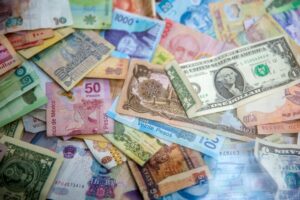The Basics of Forex: Understanding the Foreign Exchange Market
The foreign exchange market, also known as Forex or FX, is a decentralized global market where the world’s currencies are traded. With an average daily trading volume of over $6 trillion, Forex is the largest and most liquid financial market in the world. It operates 24 hours a day, five days a week, allowing traders to participate in currency trading from anywhere in the world.
Understanding the Basics:
Forex trading involves buying one currency and selling another simultaneously. Currencies are always traded in pairs, such as EUR/USD (Euro/US Dollar) or GBP/JPY (British Pound/Japanese Yen). The first currency in the pair is called the base currency, and the second currency is the quote currency. The exchange rate tells you how much of the quote currency is needed to buy one unit of the base currency.
Market Participants:
Several types of participants are involved in the Forex market. The most prominent ones include banks, central banks, corporations, hedge funds, retail traders, and brokers. Banks and central banks trade currencies to facilitate international trade and maintain their foreign exchange reserves. Corporations use Forex to hedge against currency risks involved in their global operations. Hedge funds and retail traders participate in Forex to speculate on price movements and profit from it. Brokers act as intermediaries between traders and the market, providing access to the trading platform and necessary tools.
Market Structure:
The Forex market is decentralized, meaning there is no physical location for trading. Instead, it operates through a network of electronic communication networks (ECNs), interbank markets, and over-the-counter (OTC) platforms. ECNs connect buyers and sellers directly, while interbank markets facilitate large-scale transactions between financial institutions. OTC platforms allow retail traders to access the market through online brokers.
Currency Pairs:
There are three types of currency pairs in Forex: major pairs, minor pairs, and exotic pairs. Major pairs involve the US Dollar and one of the other seven major currencies: Euro, Japanese Yen, British Pound, Swiss Franc, Canadian Dollar, Australian Dollar, and New Zealand Dollar. These pairs have high liquidity and typically lower spreads. Minor pairs, also known as cross-currency pairs, exclude the US Dollar. Exotic pairs involve one major currency and one from an emerging or smaller economy. Exotic pairs tend to have wider spreads and lower liquidity.
Factors Affecting Exchange Rates:
Exchange rates in the Forex market are influenced by various factors, including economic indicators, geopolitical events, interest rates, inflation rates, and market sentiment. Economic indicators such as GDP growth, employment data, and inflation reports can significantly impact a currency’s value. Geopolitical events, such as elections or trade disputes, can create volatility in the market. Interest rates set by central banks affect currency valuations, as higher rates attract foreign investments. Inflation rates also play a role in determining exchange rates, as high inflation erodes a currency’s purchasing power. Lastly, market sentiment, driven by investor confidence and risk appetite, can lead to rapid price movements.
Trading Strategies:
Forex trading offers various strategies to profit from price movements. Some popular strategies include technical analysis, fundamental analysis, and risk management techniques. Technical analysis involves using historical price data, charts, and indicators to predict future price movements. Fundamental analysis focuses on analyzing economic indicators, news events, and central bank policies to determine currency value. Risk management techniques, such as setting stop-loss orders and maintaining a diversified portfolio, are crucial to protect against potential losses.
Conclusion:
Understanding the basics of Forex is essential for anyone interested in currency trading. The foreign exchange market offers immense opportunities for traders to profit from fluctuations in exchange rates. By grasping the fundamentals of currency pairs, market structure, influencing factors, and trading strategies, individuals can enter the world of Forex with confidence. However, it is crucial to remember that Forex trading involves risks, and proper education and risk management are vital for success.





